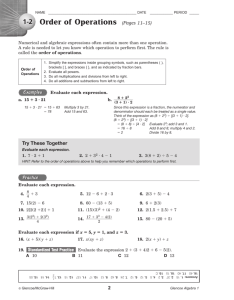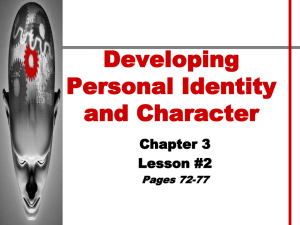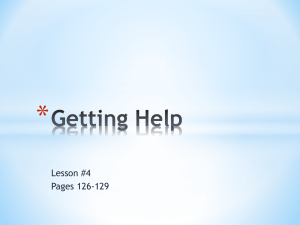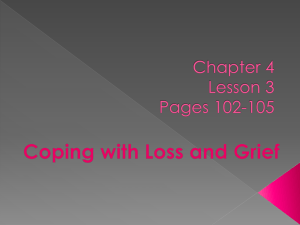Chapter 17 Test
advertisement
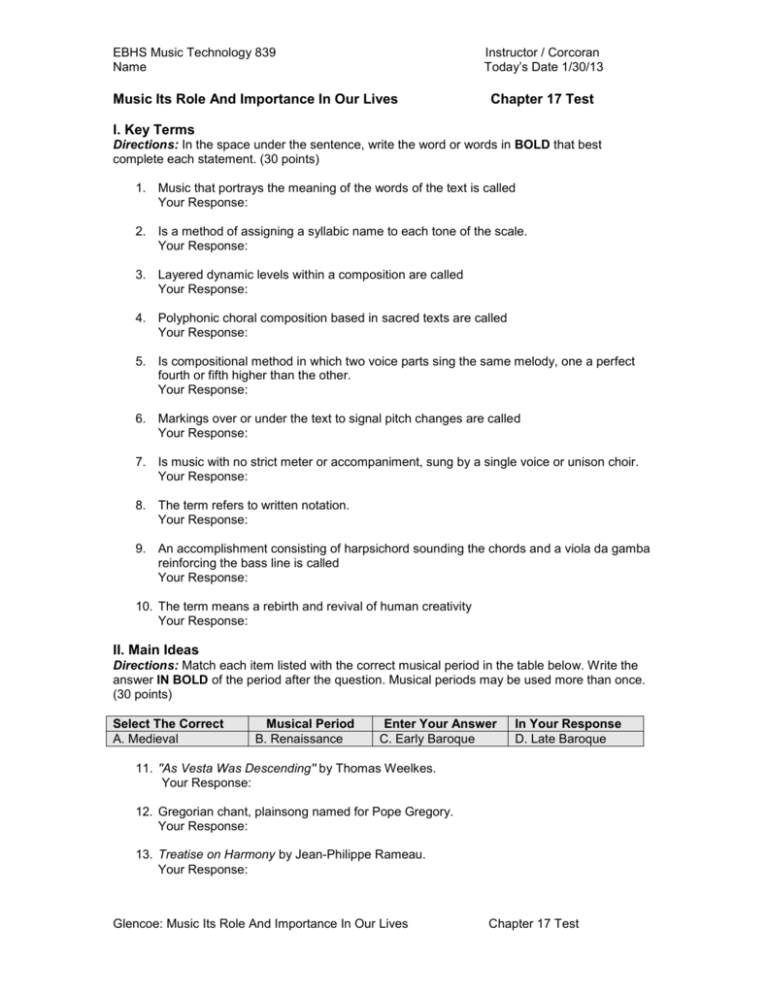
EBHS Music Technology 839 Name Instructor / Corcoran Today’s Date 1/30/13 Music Its Role And Importance In Our Lives Chapter 17 Test I. Key Terms Directions: In the space under the sentence, write the word or words in BOLD that best complete each statement. (30 points) 1. Music that portrays the meaning of the words of the text is called Your Response: 2. Is a method of assigning a syllabic name to each tone of the scale. Your Response: 3. Layered dynamic levels within a composition are called Your Response: 4. Polyphonic choral composition based in sacred texts are called Your Response: 5. Is compositional method in which two voice parts sing the same melody, one a perfect fourth or fifth higher than the other. Your Response: 6. Markings over or under the text to signal pitch changes are called Your Response: 7. Is music with no strict meter or accompaniment, sung by a single voice or unison choir. Your Response: 8. The term refers to written notation. Your Response: 9. An accomplishment consisting of harpsichord sounding the chords and a viola da gamba reinforcing the bass line is called Your Response: 10. The term means a rebirth and revival of human creativity Your Response: II. Main Ideas Directions: Match each item listed with the correct musical period in the table below. Write the answer IN BOLD of the period after the question. Musical periods may be used more than once. (30 points) Select The Correct A. Medieval Musical Period B. Renaissance Enter Your Answer C. Early Baroque In Your Response D. Late Baroque 11. "As Vesta Was Descending" by Thomas Weelkes. Your Response: 12. Gregorian chant, plainsong named for Pope Gregory. Your Response: 13. Treatise on Harmony by Jean-Philippe Rameau. Your Response: Glencoe: Music Its Role And Importance In Our Lives Chapter 17 Test EBHS Music Technology 839 Name Instructor / Corcoran Today’s Date 1/30/13 14. The Four Seasons by Antonio Vivaldi. Your Response: 15. Pope Marcellus Mass by Palestrina. Your Response: 16. "La Bourrée" from Terpsichore by Praetorius. Your Response: 17. Fugue No.16 in G minor by Johann Sebastian Bach. Your Response: 18. "Prendes I Garde" by Guillaume d' Amiens. Your Response: 19. "Tu se' morta" from Orfeo by Claudio Monteverdi. Your Response: 20. "Estampie," a dance. Your Response: III. Making Musical Connections Directions: Read each statement carefully. Answer in BOLD True or False. (15 points) 21. The word Fugue is derived from a German word meaning "chase." Your Response: 22. Secular music is the foundation of western classical music. Your Response: 23. Guido of Arezzo devised a notation system based on a five-line staff. Your Response: 24. The Greeks established the octave as the basic mathematical unit in music. Your Response: 25. Motets on sacred texts and secular madrigals were composed during the Renaissance. Your Response: III. Critical Thinking Directions: Answer the following items in paragraph form, using complete sentences. Write your answers on a separate sheet of paper. (25 points) 26. Trace the transition in harmonic texture from monophonic to polyphonic and later homophonic texture. 27. How did the sacred and secular music of the medieval period differ? Glencoe: Music Its Role And Importance In Our Lives Chapter 17 Test EBHS Music Technology 839 Name Instructor / Corcoran Today’s Date 1/30/13 V. Glencoe Chapter 16 : Student Online Self Check Quiz Results Directions: 1. Go to http://glencoe.mcgraw-hill.com/sites/0078297567/student_view0/chapter1/ 2. At the left of the page select Chapter Activities / Select Chapter / Take the Test. 3. Submit Answers / Important! Select format as text. Do not select HTML. 4. Email the reults to your GMAIL account. 5. Open your GMAIL account, open your results, copy and paste your results under this ….line. Enter your score in Your Online Quiz Score at bottom right corner of this page. Copy And Paste Your Test Results Here Your Score = Glencoe: Music Its Role And Importance In Our Lives Chapter 17 Test
